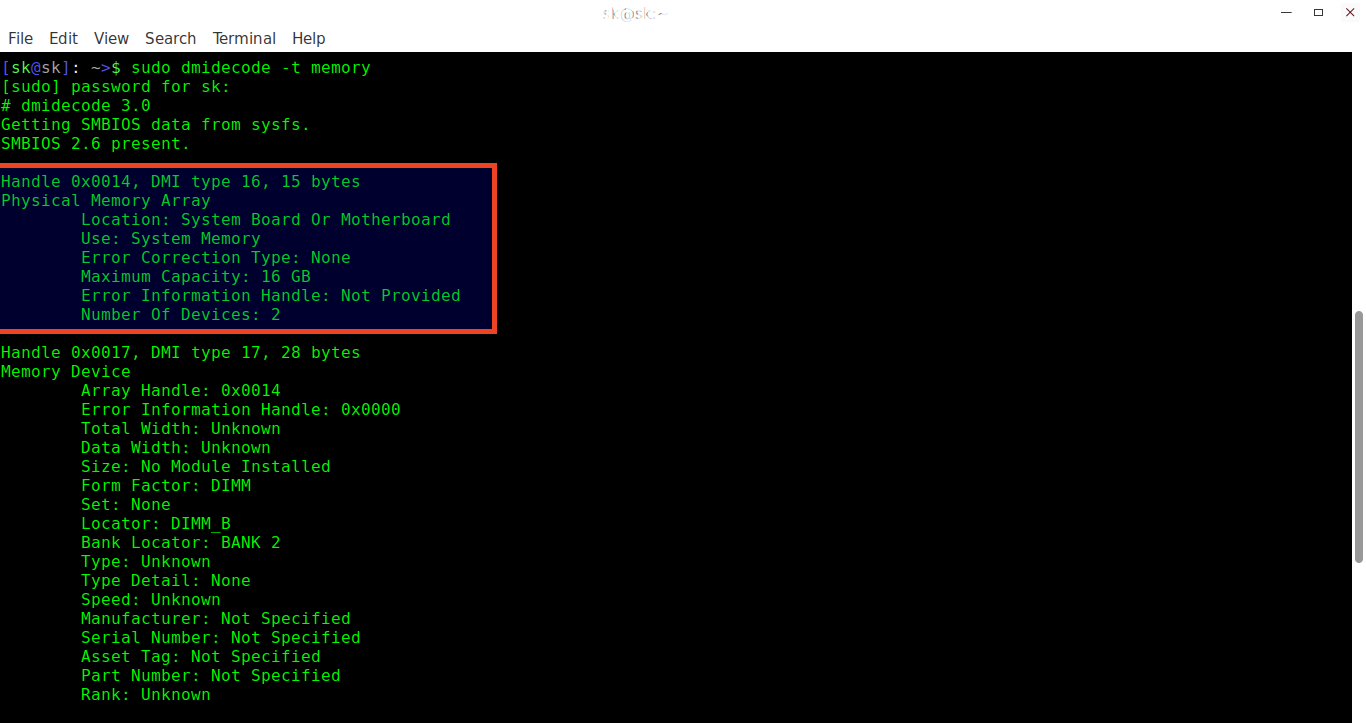Linux Command Check Memory Slots
- Check linux memory usage with the atop command. Atop is a another Linux memory usage command and system monitor. This command could be used to check linux memory usage info including per process usage. Use the apt command to install it on Ubuntu or any other Debian based distro. Sudo apt-get install atop.
- The free command is the most classic terminal based tool to check memory usage on Linux / Unix operating systems. root@server.nixcp.com: free total used free shared buff/cache available Mem: 3274 6750 Swap: 817 root@server.nixcp.com:.
Dmidecode is another command to retrieve various kind of hardware information of your Linux system. You can check memory usage in Linux with it. You can also use it to get only the processor information. Sudo dmidecode -type processor. This command needs sudo access as well. You’ll see an output like this. Unix & Linux Stack Exchange is a question and answer site for users of Linux, FreeBSD and other Un.x-like operating systems. It only takes a minute to sign up.
Here’s a useful way of finding out how many memory slots are occupied on the motherboard of a machine without removing the cover, as well as how much installed physical memory is supported.
We can use the dmidecode command to reveal your systems DMI table, which contains details of the systems hardware.
There are a whole load of DMI types we can look at – a full table of those at the end of this article.
In this particular case, we are interested in memory – type 16 ‘Physical Memory Array’ will show us how much memory is supported and DMI type 17 will reveal details of currently installed memory.
So, first off:-
dmidecode -t 16
Maximum Capacity shows us the maximum amount of memory can be installed in the machine. Number of devices tells us how many slots there are on the motherboard – in this case, 8.
Now we can interrogotate DMI type 17 – ‘Memory Device’ to show us details of installed memory
dmidecode -t 17

Each module installed will be listed with the the information given above. If we just want to know how many modules are installed and what size they are, we only really need the Size: – so we use grep
dmidecode -t 17 grep Size
From this we can see that 8x 2048MB modules are installed – so all the slots on the motherboard are populated.
There is plenty of other useful information that can be retrieved using dmidecode, including
-t1 System
-t2 Base Board
-t3 Chassis
-t4 CPU
-t9 PCI slots
Full SMIBIOS Specification
Linux Command To Check Memory Slots
1 System
2 Base Board
3 Chassis
4 Processor
5 Memory Controller
6 Memory Module
7 Cache
8 Port Connector
9 System Slots
10 On Board Devices
11 OEM Strings
12 System Configuration Options
13 BIOS Language
14 Group Associations
15 System Event Log
16 Physical Memory Array
17 Memory Device
18 32-bit Memory Error
19 Memory Array Mapped Address
20 Memory Device Mapped Address
21 Built-in Pointing Device
22 Portable Battery
23 System Reset
24 Hardware Security
25 System Power Controls
26 Voltage Probe
27 Cooling Device
28 Temperature Probe
29 Electrical Current Probe
30 Out-of-band Remote Access
31 Boot Integrity Services
32 System Boot
33 64-bit Memory Error
34 Management Device
35 Management Device Component
36 Management Device Threshold Data
37 Memory Channel
38 IPMI Device
39 Power Supply
40 Additional Information
41 Onboard Device
Translation(s): English - Français - Italiano - Русский | ?Discussion |
How to identify a device > RAM
How to identify the installed Memory / RAM.
Many people simply use free, which is available on every Debian system, to list the quantity of RAM installed (detected). Gnome users can install and use the hardinfo. KDE user can use kinfocenter.
free
free is the Unix command to know about free/used/available memory on your system:
under Gnome: hardinfo
Linux Command Check Memory Slots Free
Gnomes's System Information (Hardinfo in Menu Applications/System Tools, from package:hardinfo) has an information page on the RAM installed.
Linux Command Check Memory Slots Slot
under KDE: KInfocenter

KDE's KInfoCenter (in K Menu / System / KInfoCenter Info Center, from package:kcontrol) has an information page on the RAM installed.
dmidecode

dmidecode can be used to query the motherboards DMI zone about RAM, Ram Slot(s) and Memory Controller:
dmidecode -t memory is equivalent to running the 4 commands below (i.e dmidecode -t 5 -t 6 -t 16 -t 17)
Memory Device
Memory Controller Information
Memory Module Information
lshw
You can also check information about RAM (like speed, type, etc) using lshw (from package lshw).
References
manpages: free(1), dmidecode(8)